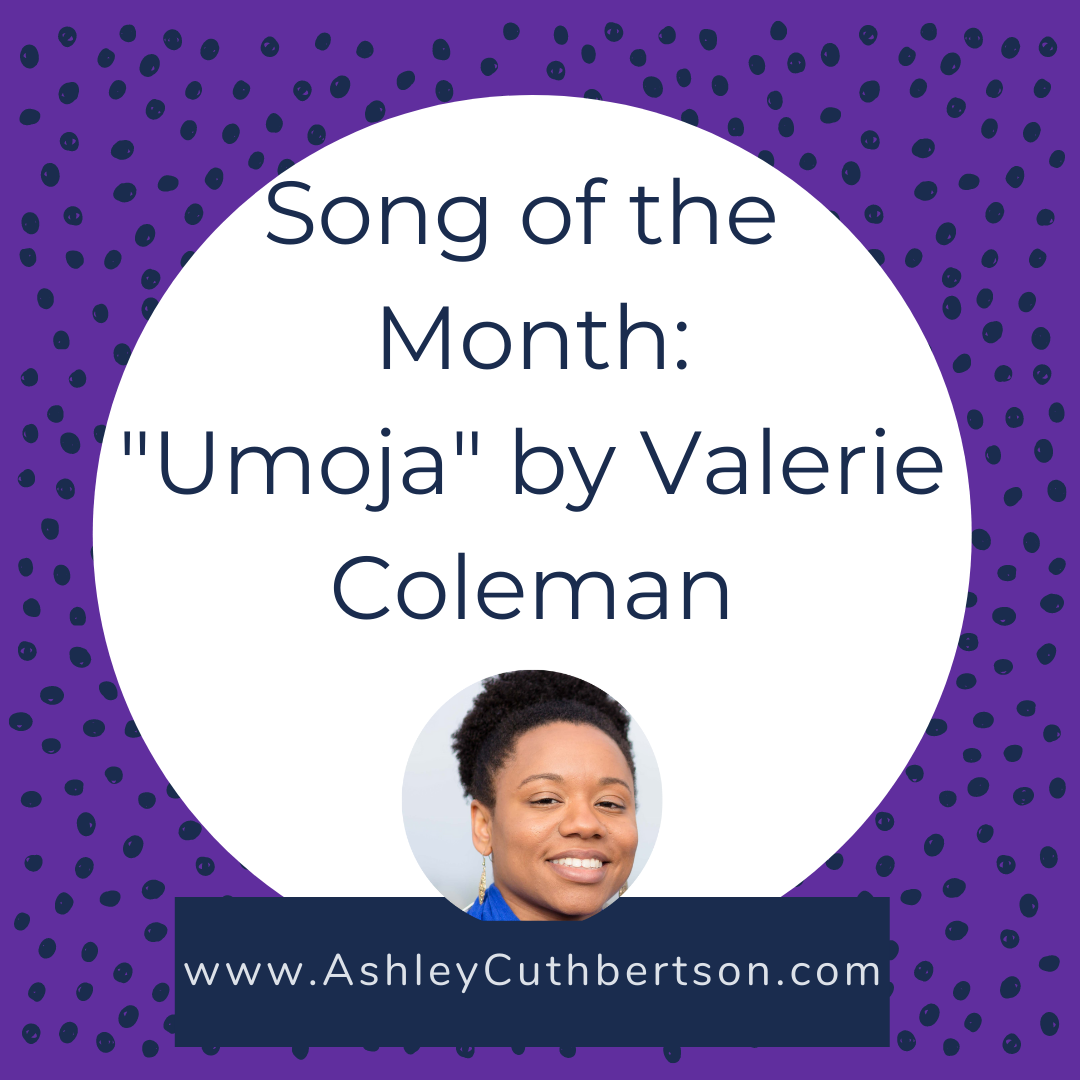Listen to this blog post by clicking on the player below!
In honor of March being Women’s History Month, I’m continuing my Song of the Month series with “Umoja” by Valerie Coleman.
I first learned about Valerie Coleman during my undergraduate studies at James Madison University. At that time, she was a member of the Imani Winds, a woodwind quintet, and they came to campus for a performance. I had volunteered to serve as an usher at their performance, and when I saw them my jaw literally dropped.
At that time, all five members of the Imani Winds were Black! You see, when I was 15, I decided that I wanted a career as an orchestral flutist, but did not know of any other Black classical musicians who were major performers at the time. To see not one, but FIVE Black classical musicians blew me away and made me feel less alone and strange for my career aspirations. #RepresentationMatters

Valerie Coleman
Valerie Coleman (who is the creator and founder of the Imani Winds), no longer performs regularly with the Imani Winds, but continues to have a rich musical career in performance, arts education, composition, and entrepreneurship. She is currently based in New York City where she recently joined the Mannes School of Music Flute and Composition faculty as the Clara Mannes Fellow for Music Leadership.
Coleman is a Grammy-nominated flutist and was named Performance Today’s 2020 Classical Woman of the Year. Her compositions have been performed by major symphony orchestras and chamber ensembles all over the US. As a performer, she has appeared as flutist in such places as Carnegie Hall, and the Kennedy Center (just to name a few!).
Additionally, Coleman is committed to education, entrepreneurship, and advocacy and created the Imani Winds Chamber Music Festival in 2011 as a summer mentorship program in New York City that welcomes young leaders from over 100 international institutions.
Valerie Coleman is truly a phenomenal musician and composer! Be sure to learn more about her on her website.
“Umoja: The First Day of Kwanzaa”
Umoja is the Swahili word for “unity” and is the first day of seven in the African-American celebration of Kwanzaa. Coleman’s original composition (“Umoja” the First Day of Kwanzaa”) was a vocal piece intended at first for family sing-along, then for women’s choir. The piece calls for unity through the tradition of call and response. Coleman rearranged the piece for woodwind quintet during her time with the Imani Winds and it soon became a signature piece of the ensemble.
In addition to the woodwind quintet version, the piece is now arranged by Coleman for flute choir, flute quartet, and orchestra. The orchestral version was commissioned by The Philadelphia Orchestra and was premiered by the orchestra at Carnegie Hall in October of 2019. This was a significant milestone for the Philadelphia Orchestra as it was the first classical work by a living African American woman that they have performed. There is also a concert band version that is under revision.
Teaching Ideas for “Umoja”
“Umoja” is such a wonderfully rich piece that could take learning in many directions!
In the band classroom, this is a great piece for intermediate to advanced players and provides a wonderful opportunity for the traditional band classroom to make space for small ensembles and chamber music. Because there are several chamber music ensemble versions, this could be performed by a flute quartet, flute choir, or woodwind quintet. Chamber ensembles are a great way to promote independent musicianship and student leadership!
In the general music classroom, “Umoja” can be a great piece for a unit on Form and Patterns because the piece is primarily in AB form. Additionally, the woodwind quintet performances of the piece are a great jumping off point to talking about various types of ensembles and woodwind instruments (you can also point out that the French horn is not actually a woodwind instrument).
Regardless of music discipline, study of the piece “Umoja” should also make space for students to learn more about themselves, others, and the world. Remember: culturally responsive music classrooms utilize a robust and multifaceted approach to teaching music that moves beyond just facts and skills.
Not only should students learn to perform the piece in the instrumental classroom, or examine it’s form and instrumental timbres in the general music classroom, but students should also engage in:
- Exploring what unity means to them and how it feels to be unified with others
- Learning about the composer, Valerie Coleman, through text, pictures, and videos
- Learning the meaning of the word “umoja” and the Swahili language
- Learning about the African-American celebration, Kwanzaa
- Examining the racial demographics of classical musicians and composers, and explore reasons why there are so few Black musicians and composers in the classical music space
- Discussion about why representation matters
- And more!
What other ideas do you have for “Umoja” in your music classroom?
I would love to hear what other ideas you have for how you could utilize “Umoja”! Share below or share on social media and tag me: I’m @ACuthbertson10 on Twitter, Instagram, and Facebook.
Also, let me know what you think of this post! If you haven’t already, be sure to sign up for my weekly email newsletter where I’ll be sending these blog posts each week, as well as other music ed resources and tips.
Until next time,
Ashley
P.S. Did you like this post? Use the buttons below to share it!
Connect with me!

You were the one who introduced me to this piece and I’m so glad you did! This piece is great for younger elementary students with its AB form. It’s also great for older elementary as an example of woodwinds (and yes, horn is not a woodwind). Thanks for all you do to bring general music instruction to the next level.
You’re very welcome, Pam! Glad you enjoyed the blog post, thanks for reading!